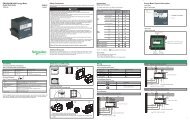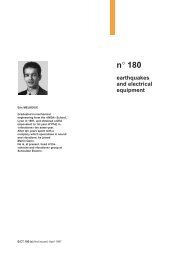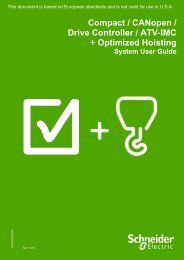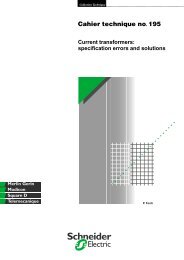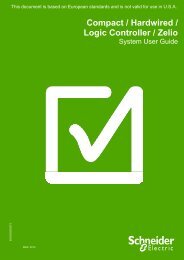Low Voltage circuit-breaker breaking techniques - Schneider Electric
Low Voltage circuit-breaker breaking techniques - Schneider Electric
Low Voltage circuit-breaker breaking techniques - Schneider Electric
- No tags were found...
Create successful ePaper yourself
Turn your PDF publications into a flip-book with our unique Google optimized e-Paper software.
Wa215Hence the curve network (Wa/W L0),(see fig. 18 ), when the limitation ratiok = i 0/ i pis introduced.Note that the smaller the ratio k, the lowerthe arcing energy. This energy is «optimal»for 1.5 < U a / E < 2.5, which was the casein steady-state current.W L01 1,5 2 2,5 31,210,950,850,750,50,30,20Fig. 18: limitation curves.k = 1k = 0,9k = 0,8k = 0,7k = 0,6k = 0,5k = 0,25UaE5.4 Under single-phase AC voltageIn limitation conditions, this current is broken asthough it were temporarily a DC voltage break.c In the symmetrical condition, in particular, itis virtually equivalent to consider <strong>breaking</strong> underprospective current with a mains voltageE = Un 2 (see fig. 19a ).c In the asymmetrical condition, limitation isoften better since the arcing voltage «breaks»the mains voltage before the current really haschance to evolve (see fig. 19b ).c In all the «intermediate» cases, with the«small loop», <strong>breaking</strong> with limitation may onlyoccur on the second current half-wave, since thestrength of the first half-wave was too low(see fig. 19c ).Remark:Efficient limitation on high short-<strong>circuit</strong> currents isonly possible if the arcing voltage appears withina time much less than T/4.ai,ubi,uciUaUn 2i p "SYM."i p "ASYM."i pi cUri cUri aT/2tT/2tti p "small loop"Fig. 19: limitation under single-phase a.c. voltage.Cahier Technique <strong>Schneider</strong> <strong>Electric</strong> no. 154 / p.16






